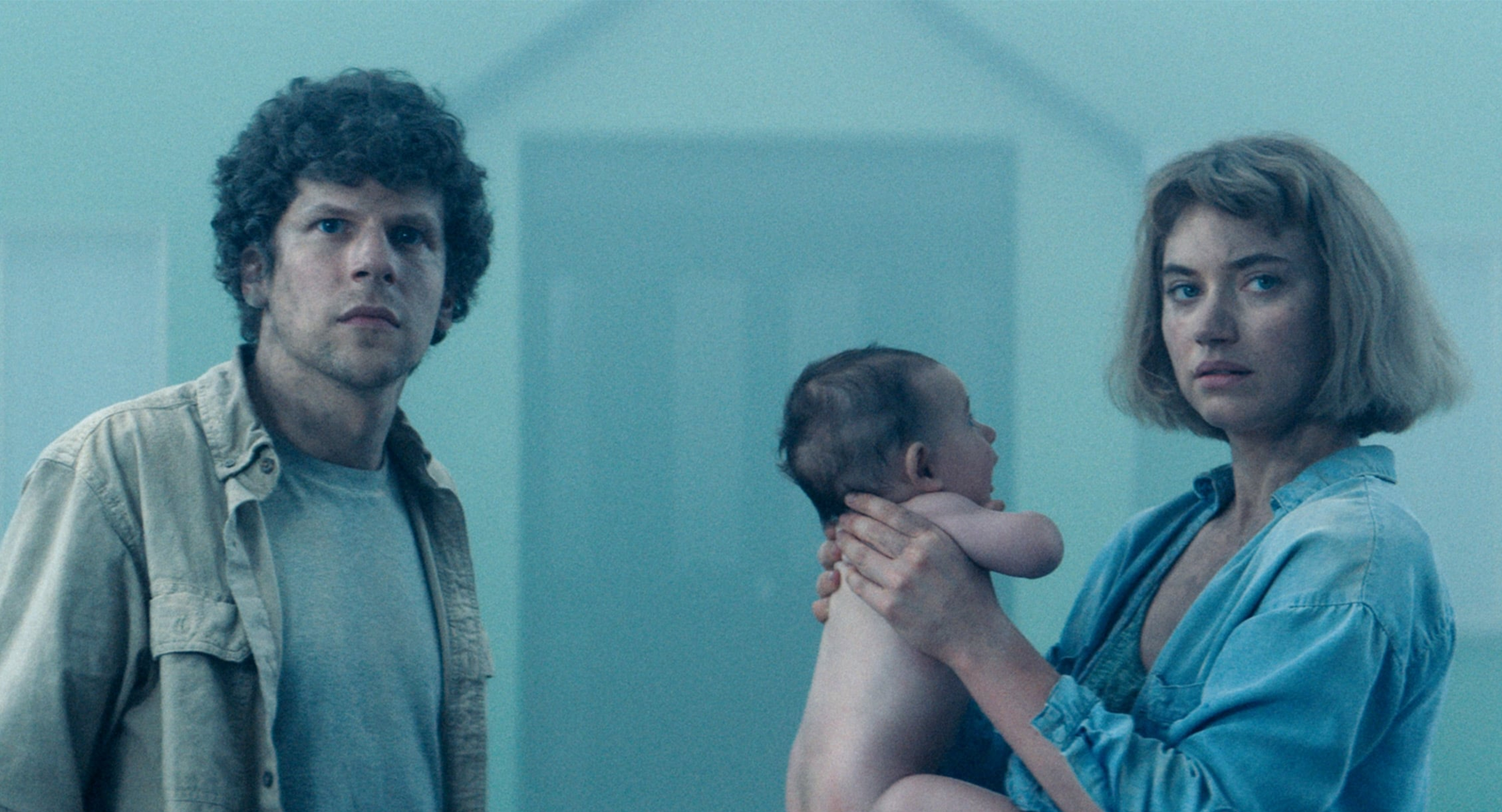A young woman and her fiancé are in search of the perfect starter home. After following a mysterious real estate agent to a new housing development, the couple finds themselves trapped in a maze of identical houses and forced to raise an otherworldly child.
Vivarium – Film Review
Published September 23, 2023

The film opens with a promising setup: a young couple, Gemma (Imogen Poots) and Tom (Jesse Eisenberg), searching for the perfect home. They are soon lured into a surreal suburban development called “Yonder,” where all the houses are identical and eerily pristine. This premise immediately sets the stage for an exploration of conformity, consumerism, and the monotony of suburban life.
One of the film’s strengths is its visual presentation. The neighborhood of Yonder is a sterile and unnerving landscape, with its rows of identical houses and perfectly manicured lawns. The cinematography by MacGregor is effective in conveying the eerie atmosphere of the setting, with its muted color palette and stark, angular architecture. The film’s visual style successfully captures the sense of isolation and dislocation that Gemma and Tom experience as they become trapped in Yonder.
Imogen Poots and Jesse Eisenberg deliver solid performances, with Poots in particular shining as Gemma. She effectively conveys the character’s growing desperation and sense of unease as the couple’s predicament becomes increasingly dire. Eisenberg’s portrayal of Tom is also convincing, though his character is unfortunately underdeveloped, leaving little for him to work with.
The film’s problems begin to emerge as the narrative unfolds. Gemma and Tom find themselves trapped in Yonder, unable to escape, and are left with only a mysterious package containing a baby boy. From here, the film descends into a series of increasingly bizarre and disjointed events. The baby grows at an unnatural rate, and the couple’s attempts to care for it become increasingly surreal and nightmarish.
The film’s descent into absurdity is both its greatest strength and its biggest weakness. While it initially creates a sense of unease and confusion that is effective in conveying the characters’ disorientation, it ultimately becomes frustrating and tedious. The lack of a coherent and compelling narrative arc makes it difficult to become emotionally invested in the characters or their predicament.
One of the film’s major flaws is its failure to provide a satisfying explanation for the bizarre events that unfold. There are hints at a larger conspiracy or supernatural force at play, but these elements are never fully explored or resolved. Instead, the film leaves the viewer with more questions than answers, which can be frustrating and unsatisfying.
The film also suffers from a lack of meaningful character development. Gemma and Tom are initially presented as a loving couple, but their relationship is never explored in depth, and their actions and motivations become increasingly difficult to understand as the film progresses. This lack of character development makes it difficult to empathize with them or care about their fate.
One of the film’s missed opportunities is its failure to fully explore the theme of suburban conformity. Yonder is presented as a symbol of suburban conformity and the soul-crushing monotony of modern life, but this theme is never fully developed. The film hints at the idea that Gemma and Tom are trapped in a nightmarish version of the American Dream, but this concept is never explored in a meaningful way.
Another frustrating aspect of Vivarium is its heavy-handed symbolism. The film is filled with obvious and sometimes ham-fisted metaphors, from the bird-like creatures that stalk the couple to the repeated imagery of a child’s drawing of a house. These symbols are so blatant that they undermine the film’s ability to engage the viewer on a deeper level, instead coming across as heavy-handed and didactic.
The film’s pacing is also a significant issue. It meanders through its increasingly bizarre and disjointed narrative, never building a sense of tension or urgency. As a result, the film’s 97-minute runtime feels much longer, and it becomes a chore to watch as it drags on without a clear sense of purpose.
Vivarium is a film with a promising premise and strong visual presentation, but it ultimately fails to deliver on its potential. While Imogen Poots and Jesse Eisenberg give solid performances, the film’s convoluted narrative, lack of character development, and heavy-handed symbolism make it a frustrating and unsatisfying experience. It is a missed opportunity to explore themes of suburban conformity and the human condition in a meaningful way. Ultimately, Vivarium leaves the viewer feeling disoriented and disappointed.
